MissSkittles
Chameleon Enthusiast
Ok. Give me a few minutes and I’ll give you a full review. While I’m working on that, can you please take some pics of your entire enclosure, including floor and lights please.
Follow along with the video below to see how to install our site as a web app on your home screen.
Note: This feature may not be available in some browsers.
please let me know if anything is wrong. I was unaware of her gender and age and I will gladly fix anything she needs to make her happiest and most comfortableOk. Give me a few minutes and I’ll give you a full review. While I’m working on that, can you please take some pics of your entire enclosure, including floor and lights please.
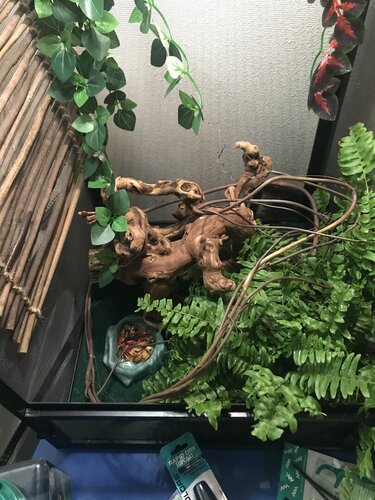
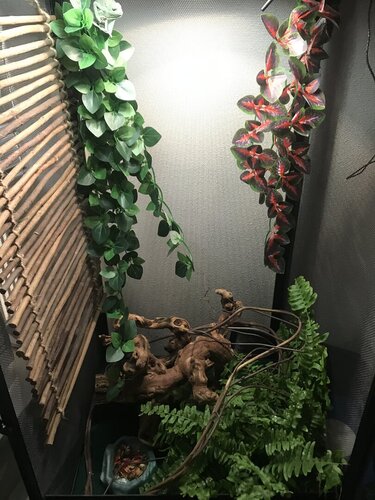
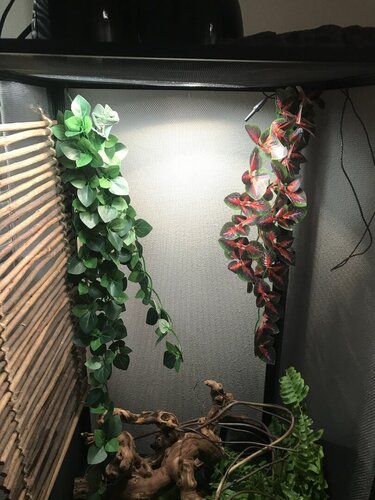
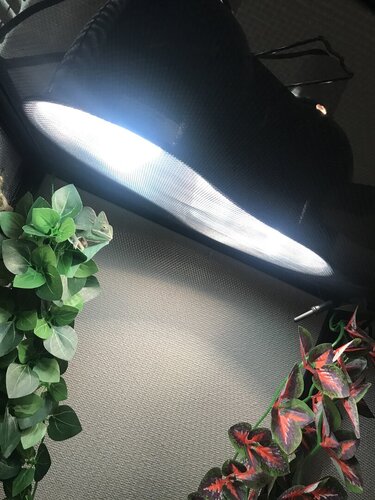
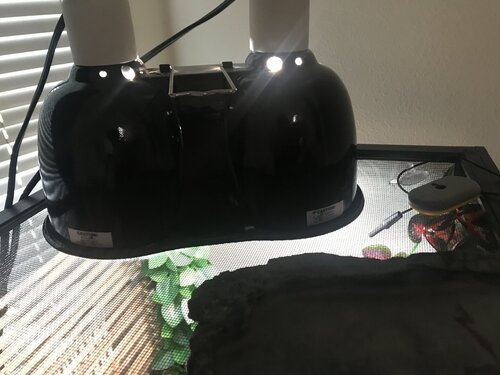
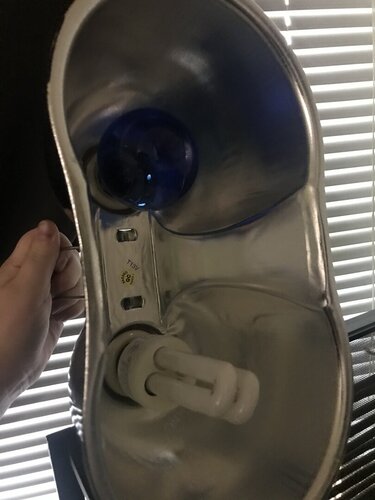
I attached an image of the lights in my prior comment. We are not currently using supplements but I surely will start! We have Flukers calcium to coat her food in currently. I use the sprayer often, when her plants are looking too dry I will spray some water on them as I've seen her drink that water fairly often. The dripper is used 3 times a day, 30 minutes after she wakes up, around 2/3 pm and around 7pm. The humidifier is on the whole time her lights are on. I did not see the chameleon she was housed with. This chameleon was apparently "horribly aggressive" and she didn't want her any longer/ was neglecting her so we rushed over to get her so she would have a better home. The girl told us she had "him" for a year and a half and that the pet store told her "he" was 6 months old when she bought "him" based on pictures how old are you assuming she is? Also I know she was housed with a tree frog as well, however he was rehired about two weeks before we got her. Also how close do you think she is to laying eggs. I will get the set up but getting it tomorrow will be easiest for me if she can wait that long.Putting my feedback in red.
- Your Chameleon - Veiled chameleon, female and between 1 and 2 years old. She has been in my care for 4 days. Honestly I’m very surprised that if the girl you got her from had her for 1-2 years, she never laid eggs. Something here is strange.
- Handling - 1 time so far Very good! She needs time to adjust and settle in.
- Feeding - She has not eaten since we've had her. we tried mealworms, crickets (dead and alive) and a variety of vegetables. Before we had her she was eating calciworms and wax-worms which are being delivered tonight. Chameleons will only eat live bugs. Mealworms are not good at all to give. Attaching feeder and gutloading sheets. You have to feed the buggies well in order to pass nutrition on to her.
What about supplements? Are you using any? If so, what and when?- Watering - A dripper, a water spray bottle and a humidifier. I have seen her drinking once a day so far. How often and when for each?
- Fecal Description - She has not been tested for parasites, and her feces is solid and light brown.
- History - She was housed with another chameleon. The person we got her from told us she was a male and was housed with a male but now that I know she is a female I'm not sure about the chameleon she was housed with. Ok. Did you see the other chameleon she was housed with? Did it look just like her or did it have a large casque? If it was a male, she could indeed have fertile eggs when she lays.
Chameleons should never ever be housed with another cham or any other animal.
Cage Info:
- Cage Type - It's a screen cage, she also has some trees around the room if she wants to leave the cage and wander. The cage is 2 feet by 2 feet by 3 1/2 feet. Ok...good. Close enough to recommended minimum of 2x2x4’ .
- Lighting - I'm not sure what the model is but it's a zoomed kit for lighting. The lights are on from 7/8 am to 8/9 pm. This is really important...is the uvb a coil screw in bulb or a long tube?
- Temperature - Cage floor is 72, basking is 84. Lowest temp at night so far has been 63. We have three thermometers. One on the floor, one at the same height as her basking area and one in the middle near her ladder (which she often hangs out on) Great with all the thermometers! You do need to cool her basking down a few degrees though. Should be no higher than about 80.
- Plants - Right now she has both live and fake plants, The fake plants are being in the process of being switched to real plants. Perfect! Fake plants are only good for fake chams. I attached my fake ones to the outside of the enclosure to provide a bit more privacy. We have a bamboo plant, and a fern plant for her. As well as a twisty tree stump and a bamboo ladder. You do need to be careful of what plants you use as she will nibble on them. Here’s the list I use. https://chameleonacademy.com/plants/
- Placement - The bottom of the cage is about 3 feet off the ground. She is next to a window in the corner of the room and not in a high traffic area unless we are going over to see her. Good. They like and feel safest when they are up higher than us.
- Location - Portland, Oregon
So she will be needing a lay bin and is best to just make it a permanent part of her enclosure. It’s pretty simple to prepare. Get a plastic container that is approx 10x10x10” ...may want to drill a few tiny drainage holes in the bottom. Fill to around 6-8” with washed play sand. It needs to be kept moist enough that it can hold a tunnel without collapsing. They don’t just dig down...they will also dig across a it.- View attachment 279973View attachment 279974
Ok, so you have some upgrades to make. You do have the coil uvb bulb which isn’t able to provide adequate uvb levels. You’ll need to get a linear T5 ho fixture with either a 5.0 or Arcadia brand 6% uvb bulb. It needs to be long enough to span the width of your enclosure...so 24”. Proper uvb is essential! Your basking light is the blue one. Colored lights aren’t good for sensitive cham eyes. You can use a plain old fashioned incandescent light bulb for basking. LED won’t put off enough heat. Halogen would work too. Start with around a 60w. Basking branches should be around 9” below your lights.please let me know if anything is wrong. I was unaware of her gender and age and I will gladly fix anything she needs to make her happiest and most comfortable
Holy crap! They housed her with not only another chameleon but tree frogs too! Oh Lord! Thank goodness you have her and are going to give her a great home!I attached an image of the lights in my prior comment. We are not currently using supplements but I surely will start! We have Flukers calcium to coat her food in currently. I use the sprayer often, when her plants are looking too dry I will spray some water on them as I've seen her drink that water fairly often. The dripper is used 3 times a day, 30 minutes after she wakes up, around 2/3 pm and around 7pm. The humidifier is on the whole time her lights are on. I did not see the chameleon she was housed with. This chameleon was apparently "horribly aggressive" and she didn't want her any longer/ was neglecting her so we rushed over to get her so she would have a better home. The girl told us she had "him" for a year and a half and that the pet store told her "he" was 6 months old when she bought "him" based on pictures how old are you assuming she is? Also I know she was housed with a tree frog as well, however he was rehired about two weeks before we got her. Also how close do you think she is to laying eggs. I will get the set up but getting it tomorrow will be easiest for me if she can wait that long.
Thank you so much